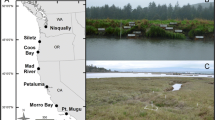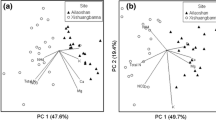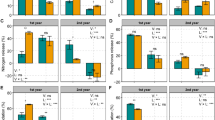Abstract
Relationships between flooding frequency, flooding duration, litter moisture levels, and litter decay rates were investigated across the natural hydrologic gradient common to intertidal salt marshes. The effects on litter decay of natural and experimental alterations of litter moisture content were assessed in both field litterbag experiments (conducted in a southern New Jersey salt marsh from 1989 to 1990) and laboratory incubations (1990). Overall, tidally mediated litter moisture content was the dominant factor controlling litter decay throughout the vegetated marsh. Rates of carbon loss were most closely related to litter moisture levels (r=0.84), which were directly related to flooding frequency (r=0.66) and duration (r=0.63). Litter moisture levels were related to elevation within the tidal range due to increasing surface levation from creekbank to high marsh (ca. 54 cm) and height of litter above the sediment surface. Carbon losses from litter of short and tall form Spartina alterniflora Loisel. and S. patens (Aiton) Muhl. along the marsh elevation gradient indicate that while some of the variations in decay rates may be due to litter type, litter moisture accounted for most of the observed variation between marsh zones and within each litter type. Mousture levels are also affected by the water retention capacity of each litter type, which may also secondarily influence decay rates. Short-term incubations of litter indicated that CO2 evolution was positively related to moisture content with negligible respiration at moisture levels below 15% (fresh mass), increasing to a maximum between 65 and 75% depending upon litter type. Since most Spartina spp. litter remains above the marsh surface where it maintains a lower moisture content than surface litter, the use of surface litterbags may overestimate rates of carbon loss in some systems. In addition, since changes in elevation of only a few centimeters had significant effects on both litter moisture levels and decay rates, slight changes in tidal regime may have important consequences for organic matter cycling in salt marshes by affecting litter decomposition processes.
Similar content being viewed by others
References
Burkholder PR, Bornside LM (1957) Decomposition of marsh grass by aerobic marine bacteria. Bull Torrey bot Club 84:366–383
Christian RR (1984) A life-table approach to decomposition studies. Ecology 65(5):1693–1697
de la Cruz AA (1973) The role of tidal marshes in the productivity of coastal waters. Bull Ass SEast Biologists 20(4):147–156
Dame RF (1989) The importance of Spartina alterniflora to Atlantic Coast estuaries. Rev aquat Biol 1(4):639–660
Day RW, Quinn GP (1989) Comparisons of treatment after an analysis of variance in ecology. Ecol Monogr 59(4):433–463
Frasco BA, Good RE (1982) Decomposition dynamics of Spartina alterniflora and Spartina patens in a New Jersey salt marsh. Am J Bot 69(3):402–406
Gallagher JL, Kibby HV, Skirvin KW (1984) Community respiration of decomposing plants in Oregon estuarine marshes. Estuar cstl Shelf Sci 18:421–431
Gallagher JL, Pfeiffer WJ (1977) Aquatic metabolism of the communities associated with attached dead shoots of salt marsh plants. Limnol Oceanogr 22:562–565
Good RE, Frasco BR (1979) Estuarine evaluation study: a four-year report of production and decomposition dynamics of salt marsh communities of the Manahawkin marshes, Ocean County, New Jersey Report to New Jersey Department of Environmental Protection Division of Fish, Game and Shellfisheries, Trenton, NJ. Rutgers University Center for Coastal and Environmental Studies CCES Publ. No. NJ/RU-DEP-11-9-79
Gosselink JG, Kirby CJ (1974) Decomposition of salt marsh grass, Spartina alterniflora Loisel. Limnol Oceanogr 19(3):825–832
Haines EB, Hanson RB (1979) Experimental degradation of detritus made from the salt marsh plants Spartina alterniflora Loisel., Salicornia virginica L., and Juncus roemerianus Scheele. J exp mar Biol Ecol 40:27–40
Hopkinson CS, Schubauer JP (1984) Static and dynamic aspects of nitrogen cycling in the salt marsh graminoid Spartina alterniflora. Ecology 65(3):961–969
Howes BL, Dacey JWH, Teal JM (1985) Annual carbon mineralization and belowground production of Spartina alterniflora in a New England salt marsh. Ecology 66(2):595–605
Kruczynski WL, Subrahmanyam CB, Drake SH (1978) Studies on the plant community of a north Florida salt marsh. Part II. Nutritive value and decomposition. Bull mar Sci 28(4):707–715
Lee C, Howarth RW, Howes BL (1980) Sterols in decomposing Spartina alterniflora and the use of ergosterol in estimating the contribution of fungi to detrital nitrogen. Limnol Oceanogr 25(2):290–303
Linthurst RA, Reimold RJ (1978) Estimated net aerial primary productivity for selected estuarine angiosperms in Maine, Delaware, and Georgia. Ecology 59(5):945–955
Mann KH (1972) Macrophyte production and detritus food chains in coastal waters. Mem Ist Ital Idrobiol 29 (Suppl): 353–383
Marinucci AC (1982) Trophic importance of Spartina alterniflora production and decomposition to the marsh-estuarine ecosystem. Biol Conserv 22:35–58
Marinucci AC, Bartha R (1982) A component model of decomposition of Spartina alterniflora in a New Jersey salt marsh. Can J Bot 60:1618–1624
Marinucci AC, Hobbie JE, Helfrich JVK (1983) Effect of litter nitrogen on decomposition and microbial biomass in Spartina alterniflord. Microb Ecol 9:27–40
McKee KL, Seneca ED (1982) The influence of morphology in determining the decomposition of two salt marsh macrophytes. Estuaries 5(4):302–309
Montagna PA, Ruber E (1980) Decomposition of Spartina alterniflora in different seasons and habitats of a northern Massachusetts salt marsh, and a comparison with other Atlantic regions. Estuaries 3(1):61–64
Moran MA, Benner R, Hodson RE (1989) Kinetics of microbial degradation of vascular plant material in two wetland ecosystems. Oecologia 79:158–167
Newell SY (1993) Decomposition of shoots of a salt-marsh grass. In: Jones JG (ed) Advances in microbial ecology. 13. University of Georgia, Sapelo Island, Georgia
Newell SY, Arsuffi TL, Kemp PF, Scott LA (1991) Water potential of standing-dead shoots of an intertidal grass. Oecologia 85:321–326
Newell SY, Fallon RD (1989) Litterbags, leaf tags, and decay of non-abscised intertidal leaves. Can J Bot 67:2324–2327
Newell SY, Fallon RD, Miller JD (1989) Decomposition and microbial dynamics for standing, naturally positioned leaves of the salt-marsh grass Spartina alterniflora. Mar Biol 101:471–481
Newell SY, Fallon RD, Rodriguez RMC, Groene LC (1985) Influence of rain, tidal wetting and relative humidity on release of carbon dioxide by standing-dead salt-marsh plants. Oecologia 68:73–79
Nixon SW, Oviatt CA (1973) Ecology of a New England salt marsh. Ecol Monogr 43:463–498
Odum EP, de la Cruz AA (1967) Particulate organic detritus in a Georgia salt marsh-estuarine ecosystem. In: Lauff GH (ed) Estuaries. American Association for the Advancement of Science Publ. 83., Washington, D.C.
Odum WE, Zieman JC, Heald EJ (1972) The importance of vascular plant detritus to estuaries. Proceedings of the coastal marsh and estuary management symposium. Louisiana State University, Baton Rouge, Louisiana
Redfield AC (1972) Development of a New England salt marsh. Ecol Monogr 42:201–237
Reice SR, Stiven AE (1983) Environmental patchiness, litter decomposition and associated faunal patterns in a Spartina alterniflora marsh. Estuar cstl Shelf Sci 16:559–571
SAS Institute Inc. (1988) SAS/STATTM User's Guide, Release 6.03. SAS Institute, Cary, North Carolina
Sokal RR, Rohlf FJ (1981) Biometry. WH Freeman and Company, New York, New York
Stumm W, Morgan JJ (1970) Aquatic chemistry. Wiley-Interscience, New York, New York
Swift MJ, Heal OW, Anderson JM (1979) Studies in ecology, Vol 5. Decomposition in terrestrial ecosystems. University of California Press, Berkeley, California
Teal JM (1962) Energy flow in the salt marsh ecosystem of Georgia. Ecology 43(4):614–624
Turner RE (1976) Geographic variations in salt marsh macrophyte production: a review. Contr mar Sci Univ Tex 20:47–68
Valiela I, Howes B, Howarth R, Giblin A, Foreman K, Teal JM, Hobbie JE (1982) Regulation of primary production and decomposition in a salt marsh ecosystem. In: Gopal GP, Turner R, Wetzel R, Whigham D (eds) Wetlands: ecology and management. National Institute of Ecology. Jaipur, India
Valiela I, Wilson J, Buchsbaum R, Rietsma C, Bryant D, Foreman K, Teal J (1984) Importance of chemical compotition of salt marsh litter on decay rates and feeding by detritivores. Bull mar Sci 35(3):261–269
Valiela I, Teal JM, Allen SD, Van Etten R, Goehringer D, Volkmann S (1985) Decomposition in salt marsh ecosystems: the phases and major factors affecting disappearance of above-ground organic matter. J exp mar Biol Ecol 89:29–54
Vince SW, Valiela I, Teal J (1981) An experimental study of the structure of herbivorous insect communities in a salt marsh. Ecology 62(6):1662–1678
White DA, Trapani JM (1982) Factors influencing disappearance of Spartina alterniflora from litterbags. Ecology 63(1):242–245
White DS, Howes BL (1994) Nitrogen incorporation into decomposing litter of Spartina alterniflora. Limnol Oceanogr 39(1):133–140
White DS, Howes BL (1994) Translocation, remineralization, and turnover of nitrogen in the roots and rhizomes of Spartina alterniflora (Gramineae). Am J Bot 81:1225–1234
Wiegert RG (1986) Modelling spatial and temporal variability in a salt marsh: sensitivity to rates of primary production, tidal migration and microbial degradation. In: Wolfe DA (ed) Estuarine variability. Academic Press Inc., San Diego, California
Zar JH (1984) Biostatistical analysis. Prentice-Hall Inc., Englewood Cliffs, New Jersey
Author information
Authors and Affiliations
Additional information
Communicated by J. P. Grassle, New Brunswick
Rights and permissions
About this article
Cite this article
Halupa, P.J., Howes, B.L. Effects of tidally mediated litter moisture content on decomposition of Spartina alterniflora and S. patens . Marine Biology 123, 379–391 (1995). https://doi.org/10.1007/BF00353629
Received:
Accepted:
Issue Date:
DOI: https://doi.org/10.1007/BF00353629




